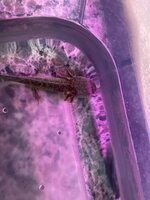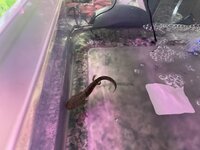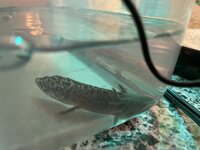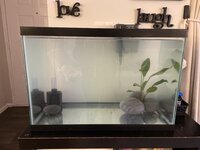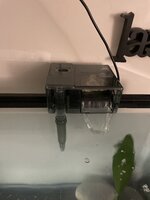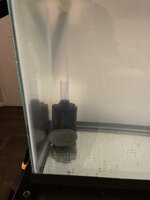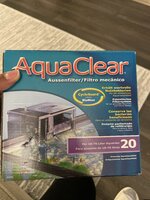Alextheaxie
New member
Hey everyone,
I am new to owning an axolotl and admittedly I should have done a ton of research when my daughter asked for one. She and I had now clue what we we getting ourselves into especially being new to water animals. Well we’re here now, and after tons of googling and YouTube videos I have found that we should have cycled our tank first and I’m now currently tanking Alex. We got him because our neighbor (Alex) told us that the exotic pet shop had two the just received and that it was going to go up in price the following week so we purchased him, and all of the equipment the same day and I have been battling everyday to preserve his(of her) life. We’ve had him for about 3/4 weeks and he is only 3inches long. The reason I am asking for help is because I have been getting tons of conflicting information. The pet shop told me that I would be fine adding him to the tank on day one as long as I used fritz turbo start 700 and Prime water conditioner. So I added those products to the tank and our axie the same day. Then I read about cycling. Then our neighbor bought us a 20 gallon to put him in and I did the same thing added the fritz and prime and Alex. I also bought a API water testing kit because after reading about cycling I was confused on if I should or shouldn’t keep him in the tank. So I tested the water on the first test the ammonia read 0 nitrite 0 and nitrates 0.5 then on the second and third it has read ammonia 0.25, nitrite 0.25 and 5.0 for nitrate. The third ammonia 0 nitrite 0.25 and nitrate 5.0 so I am not sure what to do I noticed the other day that it looked as if he/she had a white film over them and the when I rubbed him I notice the slime coat shedding which I have read is bad, he’s also not happy after taking him out of the tank. I hope someone can please tell me how to save him his gills also look like the are regressed? I am not sure if I should completely start a new cycle over ? And tub him in the meantime or just continue to test the water parameters? Please help he so cute and I don’t want to be a bad axolotl owner


I am new to owning an axolotl and admittedly I should have done a ton of research when my daughter asked for one. She and I had now clue what we we getting ourselves into especially being new to water animals. Well we’re here now, and after tons of googling and YouTube videos I have found that we should have cycled our tank first and I’m now currently tanking Alex. We got him because our neighbor (Alex) told us that the exotic pet shop had two the just received and that it was going to go up in price the following week so we purchased him, and all of the equipment the same day and I have been battling everyday to preserve his(of her) life. We’ve had him for about 3/4 weeks and he is only 3inches long. The reason I am asking for help is because I have been getting tons of conflicting information. The pet shop told me that I would be fine adding him to the tank on day one as long as I used fritz turbo start 700 and Prime water conditioner. So I added those products to the tank and our axie the same day. Then I read about cycling. Then our neighbor bought us a 20 gallon to put him in and I did the same thing added the fritz and prime and Alex. I also bought a API water testing kit because after reading about cycling I was confused on if I should or shouldn’t keep him in the tank. So I tested the water on the first test the ammonia read 0 nitrite 0 and nitrates 0.5 then on the second and third it has read ammonia 0.25, nitrite 0.25 and 5.0 for nitrate. The third ammonia 0 nitrite 0.25 and nitrate 5.0 so I am not sure what to do I noticed the other day that it looked as if he/she had a white film over them and the when I rubbed him I notice the slime coat shedding which I have read is bad, he’s also not happy after taking him out of the tank. I hope someone can please tell me how to save him his gills also look like the are regressed? I am not sure if I should completely start a new cycle over ? And tub him in the meantime or just continue to test the water parameters? Please help he so cute and I don’t want to be a bad axolotl owner

